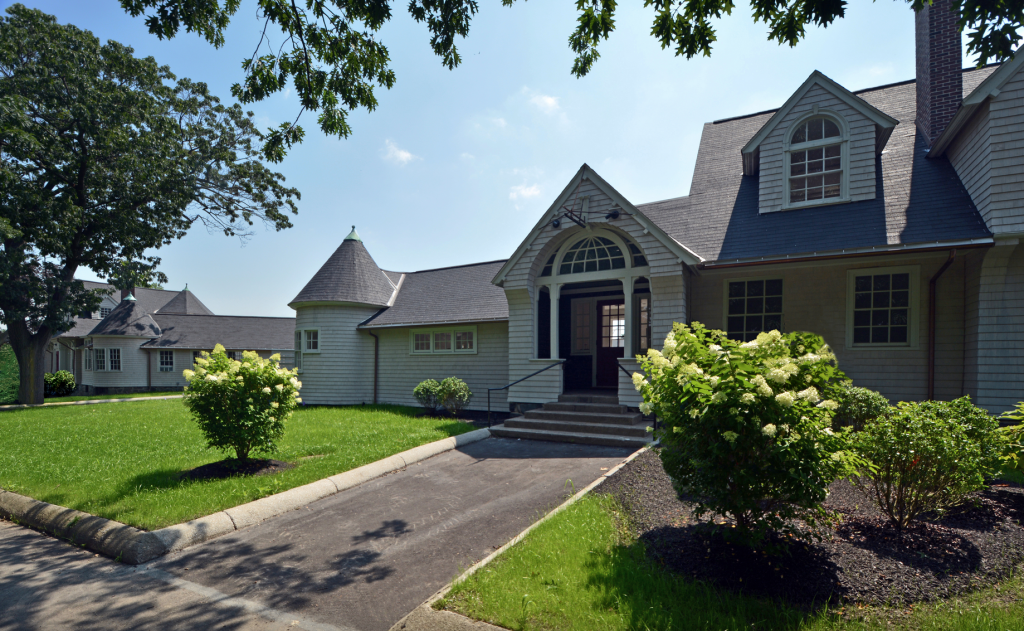1st Place, Adaptive Reuse
The Charles River Speedway is a multi-building reuse project that combines historic preservation and forward-thinking sustainable design. It repositions a 19th century stable and parks department into a versatile new public courtyard encircled by a brewery, brewpub, restaurants, retail, and informal indoor/outdoor event spaces. Historically, its neighboring sites along the Charles River were occupied by slaughterhouses and agricultural sites. The original buildings included a cow barn, trotting horse stalls and sulky storage among its more benign elements, as well as a small jail that gradually expanded as animals were moved from the site.
Known for its sensitive restoration and reuse of historic buildings, Bruner/Cott Architects’ new program for the project, developed in collaboration with Boston’s Architectural Heritage Foundation, is significant in terms of urban design. It dramatically transforms the Speedway’s locked-down and fire-damaged 2-acre locale into a lively, mixed-use destination in the Allston-Brighton neighborhood of Boston.
COMPLEX BEGINNINGS
The complex was constructed in 1899 by the Metropolitan Park Commission as a headquarters to support a new Charles River parkway, which turned a stretch of tidal mudflats into an interconnected series of public parks. This development included a mile-long horse and bicycle racetrack, which became one of the city’s most popular gathering areas.
Designed by William D. Austin in the Shingle Style with Colonial Revival influences, the buildings’ architecture mimicked the styles often found in luxurious seaside escapes, such as Newport, R.I., reinforcing the premise that outdoor recreation and the enjoyment of leisure time was meant for all. An irregular roofline connected its six buildings, creating a single- story courtyard. The arched gable entrances, porches, double-hung windows and elaborate wood trim created an overall composition characteristic of Austin’s architectural work.
In later years, the facility housed the now-defunct Metropolitan District Commission Police. Many of the original horse stables were altered and extended when they were converted into vehicular garages to support parks maintenance crews. Over time, the rise of automobiles affected the complex in various ways.
Ultimately, the racetrack was razed mid-20th century to make way for Soldiers Field Road. The Speedway headquarters buildings were used for various purposes until the 1990s, then slowly fell into disuse. Hidden in plain sight, the facility was largely abandoned by 2005. Portions of the buildings began to decay over time, and one section suffered a fire. The resulting effect was analagous to deindustrialized sites where an entire urban precinct becomes impenetrable and displays neglect.
Today, the reintegration of large, disused historic sites into the present life of neighborhoods and cities is often a major attribute of their conversion to new uses. For decades, Boston-area historic preservation advocates understood the past significance of the Speedway, its architectural quality and the reuse potential of the complex. They continually rallied support to restore its buildings and revitalize its signature courtyard, eventually succeeding following several key benchmarks: In 2010, the Speedway was added to the National Register of Historic Places and Preservation Massachusetts included the site on its list of Most Endangered Historic Places. In 2013, the Speedway was nominated as a Boston Landmark.
Owned by the Commonwealth of Massachusetts and part of the Department of Conservation & Recreation’s (DCR’s) Historic Curatorship Program, DCR created a long-term lease opportunity for developers later that year. The increased attention led to DCR, the Boston Preservation Alliance, Historic Boston Incorporated, and the Brighton-Allston Historical Association to organize a public charette the following year, generating ideas and community feedback about the site’s future. The area’s state representative continued to advocate for the rehabilitation of the site as a resource for the community. In 2014, the non-profit Architectural Heritage Foundation was named the curator partner for the renaissance project. After years of work—and despite a serious fire and a global pandemic—the Charles River Speedway opened its doors to the public in summer 2021.
EXPECTATIONS EXCEEDED
The result of the Bruner/Cott Architects and Architectural Heritage Foundation collaboration on the Speedway produced results exceeding all expectations of how this complicated site could be transformed. The historic buildings and their central courtyard now form a space for gathering and year-round activities, attracting a new generation of Bostonians. Inviting all to eat, drink, shop and connect with the neighborhood, the renewed venue supports numerous commercial uses, including small retail shops and makerspaces; shared offices; a restaurant and cafés; a publicly accessible community courtyard with stage and lighting for performances; a large event space housed in the former multi-vehicle garage space; and an anchor tenant, Notch Brewing.
To preserve and transform the complex, piecemeal garage extensions at historic
stable frontages were removed. Lost features, including wooden decks for access to stables and carriage cleaning, sliding barn doors and original windows were reimagined. In the courtyard, a new wooden ramp now unifies original building entrances for accessibility, starting from the same grade level and extending as a stage for outdoor performances. Within the original manager’s house and police station, damaged interior plaster was removed to add insulation. Fieldstone foundations for stables, the house, and offices were reinforced with concrete and repointed. Former stables and the 1940 concrete garage were fitted with recessed glazed fronts and overhead doors that connect them directly to adjacent outdoor spaces, providing visual continuity between the upper courtyard and the lower events space.
The project employs a 100 percent electric mechanical system, which will become carbon-free as Boston actively decarbonizes its electric supply. The team approached the mechanical design with air-source heat pumps, which reduced the amount of ductwork and piping needed compared to an air system, and incorporated all 169 existing operable windows as a part of the ventilation strategy, eliminating the need for almost all ductwork. The envelopes leverage the low cost and carbon of cellulose insulation and include new detailing to promote drying of the roof and wall sheathing while maintaining the restored historic profiles of the existing buildings. This was accomplished through the development of a ventilation system under the roof sheathing. The new cladding system incorporated a drainage plane to create a wall assembly open to vapor movement and protect the new cedar shingles by promoting drying throughout the year. The new uses required sprinkler installation in all buildings.
“Nice project for the community and nice to see all-electric. The project seems simple, but sometimes achieving simple is a difficult task.”
Charles Van Winckle, vice president, Thornton Tomasetti’s Renewal practice, Metamorphosis Awards Judge
NEIGHBORHOOD CONTINUITY
The site now includes a complex, sub-surface stormwater recharge system to divert runoff from the adjacent Charles River. The basement and slab design implement a variety of barrier strategies at the building’s foundation to prevent ground contamination by VOCs leftover from previous uses from entering interior spaces. This includes sheet barriers at slabs, clear sealing systems at historic fieldstone foundations so they can remain exposed and sub-slab ventilation systems.
The Speedway project reawakened its historic structures while emphasizing their original architecture; introduced new businesses with unit sizes, infrastructure and lease arrangements to favor startups; created a new communal open space within walkable distance from an increasingly dense neighborhood; and retained only the slightest hints of its 1899 and 1925 jail cells. The site is once again a vibrant source of connection and neighborhood continuity.
Retrofit Team
METAMORPHOSIS AWARD WINNER and ARCHITECT: Bruner/Cott
Architects
GENERAL CONTRACTOR: D.F. Pray General Contractors
MEP/FP ENGINEER: BLW Engineers
STRUCTURAL ENGINEER: Silman
LANDSCAPE ARCHITECT: Klopfer Martin Design Group
HISTORIC PRESERVATION: MacRostie Historic Advisors
LIGHTING DESIGN: Lewis Lighting, (857) 816-3663
ACOUSTICS: Boston Light & Sound
GEOTECHNICAL ENGINEER: GEI
WINDOW REPAIR/RESTORATION: Boston Sash & Millwork and Alpine Environmental
Materials
White Cedar Shingles: Maibec
Weather Barrier: Slicker HP from Benjamin Obdyke
Asphalt Shingles: XT 25 Moire Black from CertainTeed
Overhead Doors: 511 Series from Overhead Door
Aluminum Entrances: Series 3000 from Oldcastle BuildingEnvelope
Fans: i6 from Big Ass Fans and XP8 from Hunter Fan Co.
Heat Pumps: VRV from Daikin
Plumbing Fixtures: Elkay, Chicago Faucets, Fiat Products, American Standard and Zurn
Water Heaters: A. O. Smith and Watts
Lighting: Acuity Brands, Hinkley, Troy Lighting, Bock Lighting, Lightolier, Liton, Murray, Bartco, Barn Light Electric Co., B-K Lighting, Lumec, Lithonia and ELA Lighting
Lighting Controls: Crestron Electronics
Tile: Daltile and Crossville
Drywall: Ecosmart from USG
Epoxy Flooring: Dur-A-Flex










